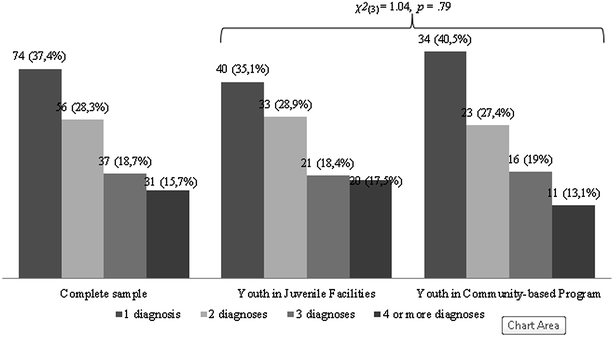Mental health problems in male young offenders in custodial versus community based-programs: implications for juvenile justice interventions
- PMID: 27822300
- PMCID: PMC5088680
- DOI: 10.1186/s13034-016-0131-6
Mental health problems in male young offenders in custodial versus community based-programs: implications for juvenile justice interventions
Abstract
Background: Young offenders are known to be a population with high prevalence of mental health disorders. In most cases, these disorders are neither identified nor treated properly, with the majority of them being chronic and difficult to treat. In many countries, the prevalence rates of psychopathology in male young offenders are still unknown and no psychotherapeutic interventions are delivered. Therefore, the main goal of the present study was to assess mental health problems in Portuguese male young offenders placed in either custodial or community-based programs and discuss treatment implications within the juvenile justice interventions.
Methods: Participants in this study included 217 male young offenders aged between 14 and 20 years old that were randomly selected using a random number table. From the total sample, 122 (56.3 %) participants were placed in juvenile detention facilities, and 95 (43.7 %) were receiving community-based programs. Participants were interviewed with the Mini-International Neuropsychiatric Interview for Children and Adolescents, a structured interview that assesses DSM-IV Axis I Mental Disorders. Participants aged 18 years or older were also assessed with the antisocial personality disorder section from the Structured Clinical Interview for DSM-IV Axis II Personality Disorders.
Results: Results showed a high prevalence of mental health disorders, with a global prevalence of 91.2 % in the total sample. In both groups, global prevalence rates were equally high (93.4 % in youth in custodial versus 88.4 % in youth in community-based programs). Substance-related disorders were more prevalent in youth placed in juvenile facilities, whereas anxiety and mood disorders were more often found in the community-based group. Moreover, oppositional defiant disorder was more prevalent in youth from the community, whereas antisocial personality disorder and conduct disorder were less prevalent than expected in this same group. A high comorbidity rate was also found, with the majority of participants from both groups' fulfilling criteria for two or more disorders. Additionally, participants with conduct disorder were over four times more likely to fulfill criteria for substance abuse.
Conclusions: Our findings inform about specific needs concerning mental health intervention that should be taken into account when deciding and planning rehabilitation programs for male young offenders, either from custodial or community-based programs.
Keywords: Custodial versus community-based programs; Juvenile justice interventions; Male young offenders; Mental health problems; Prevalence rates.
Figures


References
-
- Penner E, Roesch R, Viljoen J. Young offenders in custody: an international comparison of mental health services. Int J Forensic Ment Health. 2011;10:215–232. doi: 10.1080/14999013.2011.598427. - DOI
LinkOut - more resources
Full Text Sources
Other Literature Sources
Medical

